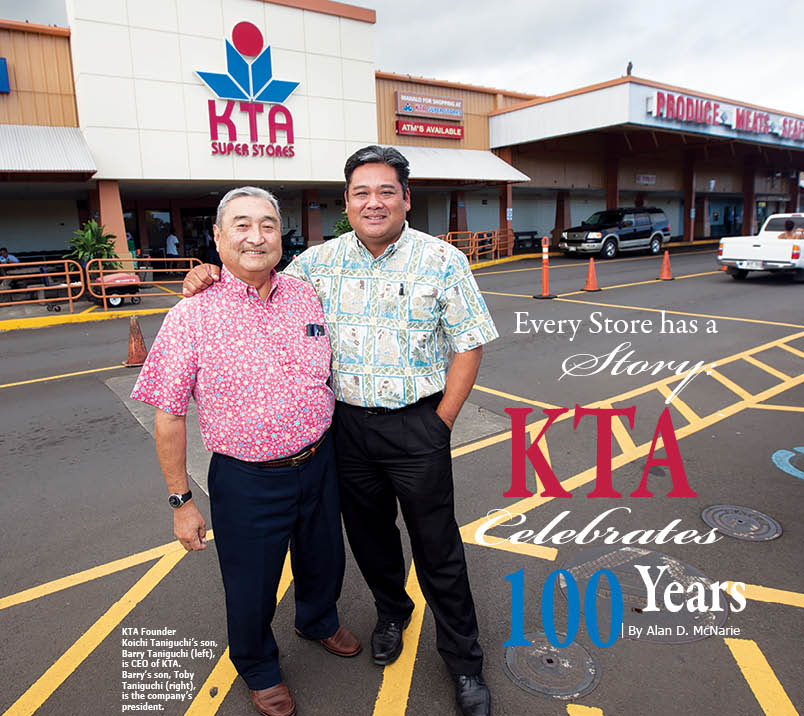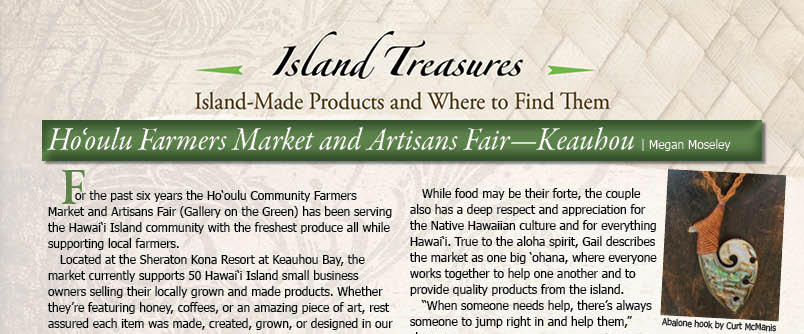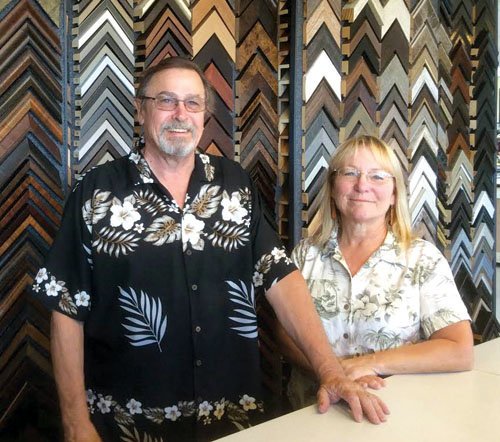
Every Store has a Story: KTA Celebrates 100 Years
By Alan D. McNarie
It looks, at first, like a typical modern supermarket: row on row of gleaming shelves and glass-fronted coolers, a meat counter, a deli, a bakery.
Look a little closer, and you’ll start to see the things that make this place something that could only exist in Hawai‘i. Start with the entire section displaying dozens of varieties of poke: that uniquely Hawaiian delicacy that combines raw seafood with flavorings from the island’s diverse ethnic communities—from scallops in Japanese Ponzu sauce to “Ahi Korean.” Nearby, there’s a whole cooler unit devoted to various brands of tofu, including several from small companies based in Hilo. A rack in the produce department holds bags of poi. Scattered around nearly every section of the store are dozens of “Mountain Apple” brand products, all grown or produced on Hawai‘i Island: everything from local grass fed beef (including some cuts ready-marinated with teriyaki sauce), to liliko‘i jams and marshmallows, to chili-pepper jelly, and to “Da Kine Chips” made from taro and sweet potatoes.
Welcome to KTA, a local success story that’s celebrating its 100th year of business this year.
“I know people come from the other islands just to pick up our poke,” remarks Debra Arita, standing on a catwalk that circles high above the store’s sales floor. Debbie is the assistant to Barry Taniguchi, the store’s CEO, and stands in as his spokesperson when he’s traveling. She’s enjoying a view that customers almost never see, one that’s all-too familiar to the store’s behind-the scenes staff, who have to merely step out their office doors to see what’s going on with the clerks and customers below.
The Mountain Apple line now includes more than 425 products from 38 vendors, “not including products made in house such as sushi and poke,” says Debbie. Each store, she notes, has some Mountain Apple specialties that only they make; the Kona store, for instance, is responsible for an “awesome Chantilly cake dessert in a cup that I love.”

Debbie’s boss, Barry, has said that the reasons for the chain’s success are “multiple” including strong support from the community and from their employees. He often uses the word “humbling” when he talks about the fact that KTA has been around so long.
The company has support from the community and its employees because of how the company itself has acted and the traditions it’s established. How that mutual company and community relationship evolved is a tale that combines equal parts of the Hawaiian traditions of aloha and lōkahi—which translates roughly as “working together”—and a generous dose of the Japanese principle of kaizen, or “continuously striving for improvement,” along with large dollops of family solidarity and community spirit. The company was lucky enough to hit on that magic combination early on, and to maintain it for four generations.
KTA officially began before July 1916, when an unassuming little 500-square-foot grocery and dry goods shop opened in Hilo, across the street from the spot where the Suisan Fish Market stands today.
The real start of the story, however was a few years earlier, when a young man named Koichi Taniguchi arrived in Hilo from Japan, without enough money left to pay his passage the rest of the way to California, where he was supposed to take over from his father as gardener on an estate in San Jose. Koichi only meant to stay in Hilo long enough to earn the rest of his passage. However, he fell in love with the island. Then he fell in love with a girl named Taniyo, and married her.
To support themselves, Koichi and Taniyo began delivering groceries around town by bicycle, until they had enough money to open their 800-square-foot “real store.” Their little mom-and-pop store found a ready market in the growing Japanese-American neighborhood of Shinmachi, which then clustered along the bayfront between the Wailoa River and downtown Hilo. They lived upstairs over the shop. Koichi headed the business and took care of the flow of goods from mainland and Japanese suppliers to the store’s shelves. Taniyo did the accounting and publicity, in addition to taking care of the couple’s nine children—as well as customers’ kids. She was known for welcoming shoppers’ children with handfuls of candy.
That first store was called K. Taniguchi Shoten (shoten is “store” in Japanese). The chain’s current name originated on Hilo’s docks. “When Koichi and Taniyo ordered products from Japan, they would have initials on their box—KT in a diamond,” recounts Debbie.
“Another store had the same initials. Koichi said, ‘We’re going to add a letter, an ‘A’ to distinguish from that other store.’ ”
The original KTA store, along with Shinmachi, disappeared in the waves of Hilo’s 1946 tsunami. By then Koichi and Taniyo had opened a second store in downtown Hilo. Based on the amount of silt and debris under the second store, Debbie believes it was probably damaged by the 1960 tsunami—yet it survived, and was later expanded.
The family survived, too. They lost one son, Toshiyuki, to a hunting accident. The two oldest sons, Yukiwo and Hidetoshi, went back to Japan to study business in Hiroshima then returned to join the company. Their youngest son, Tony, studied at UH-Mānoa. When Koichi retired, Yukiwo succeeded him as KTA’s CEO; he was succeeded, in turn, by Tony.
Now, a century later, KTA has grown into a chain of six supermarkets around the island, with nearly 800 employees. The Taniguchi family opened their first Kona supermarket in 1959, with Hidetoshi in charge. In 1965, they began construction on a new flagship store on ten acres of former cane land in Puainako, on the outskirts of Hilo. That store was followed by KTA in Keauhou in 1984, Waimea in 1990, and finally by KTA Waikoloa Village Market in 1990.
With each new store, KTA brought along a company culture that combined community service with innovation. In the early days of their first store, for instance, when automobiles were still a relatively new thing on the island, Koichi and Taniyo invested in a truck to haul goods from the wharf to the store and to make deliveries to plantation communities along the Hāmākua Coast.
Long before the credit card was invented, the Taniguchis extended store credit to their downtown Hilo store customers until payday, even giving out groceries in exchange for the promise of fresh produce.
“On payday, long lines would form outside the downtown store, which functioned as a local bank where workers could cash in their paychecks before shopping,” according to a short store history called “A Century of Serving the People on the Big Island.”
The chain’s website claims a long line of other innovations: the island’s first self-service meat department (the downtown Hilo store, 1956), the first in-store bakery in the state (Puainako store, 1977), the first supermarket in the state with barcode readers at all checkout counters (1979), and the island’s first grocery with a full-scale deli department (Keauhou, 1984).
In 2007, the company’s Waimea and Waikoloa stores joined the photovoltaic revolution, with rooftop panels to generate in-house electricity.
Of course, there’s the Mountain Apple branding program, which launched in 1994 in the wake of the closure of the island’s sugar plantations. “KTA recognizes there is more at stake than simply identifying new economics to succeed sugar,” one company document notes, explaining the motivation behind Mountain Apple. “There are concerns for diversifying the island’s agriculture, and for preserving green space and the easy going aloha spirit and rural lifestyle of Hawai‘i Island. Most of all, there is concern for the stalled mobility of the people of Hawai‘i.”
To this day, small farmers and businesses that might not have enough production or financing to market their products on their own can get their start under Mountain Apple’s umbrella.
The involvement of the chain, and the Taniguchi family, in the island community goes well beyond Mountain Apple. Barry heads the local Boy Scout Council. The company actively supports charities and nonprofit institutions such as the American Heart Association, the Hilo Medical Center, the North Hawai‘i Community Hospital and the Friends of the Children’s Justice Center.
KTA has sponsored local sports teams and donated to local schools, including UH-Hilo and a Hawaiian immersion program, ʻAha Pūnana Leo. It has also supported the host culture in other ways, too. The shelves of its stores bear bar codes, for instance, which allow those with a cell phone to read the names of various products in Hawaiian.
KTA remains a privately owned family business, and the Taniguchis remain at the heart of it. Barry is Koichi’s grandson; he succeeds his father Yukiwo and his uncle Tony in that position. Barryʻs son Toby is the company’s president. At least a half-dozen family members hold various positions in the company. It may seem a bit old-fashioned in the modern world of mega-corporations, yet somehow this family business has not just survived, it has thrived, despite the competition from national chains such as Safeway and even the advent of big box discounters such WalMart and Target on their home turf.
So what, really, is the secret of KTA’s success?
It may be even simpler than uniting lōkahi and kaizen. Koichi and Taniyo, and their children after them, have loved and cared for Hawai‘i Island, and Hawai‘i Island has loved them back. ❖
Contact KTA
Contact writer Alan D. McNarie



